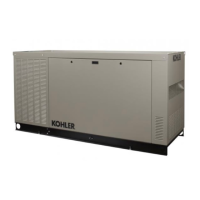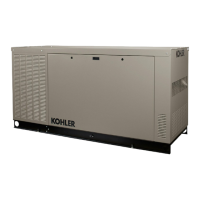TP-6811 7/16 87Section 6 Component Testing and Adjustment
6.8.1 Fuel Solenoid Valves
Two 12 VDC solenoid valves are mounted upstream of
the engine on the generator set skid. See Figure 6-14.
The fuel solenoid valves provide automatic fuel on/off
control. See Figure 6-14. The engine starting battery
powers the solenoid valve and the engine starting
controls open the valves when the engine cranks or
runs.
Fuel Valve Operation Test Procedure
1. Disconnect the positive (+) battery lead from the
gas valve terminal.
2. Apply 12 VDC to the gas valve terminal and listen
for an audible click, indicating that the valve
actuates.
3. Replace the gas valve if it does not actuate in
step 2.
6.8.2 Checking the Fuel Pressure
Connect a pressure gauge or manometer to the port on
the bottom of the second (downstream) fuel solenoid
valve to measure the fuel pressure to the engine. See
Figure 6-14 and Figure 6-15.
Measure the fuel pressure with the generator set
running at rated load. The fuel pressure should b e
5--11 in. water column or 1.2--2.7 kPa. Contact the fuel
supplier if the inlet pressure is not within the specified
range.
1
GM82797
1. Fuel pressure port
Figure 6-15 Fuel Solenoid Valve






